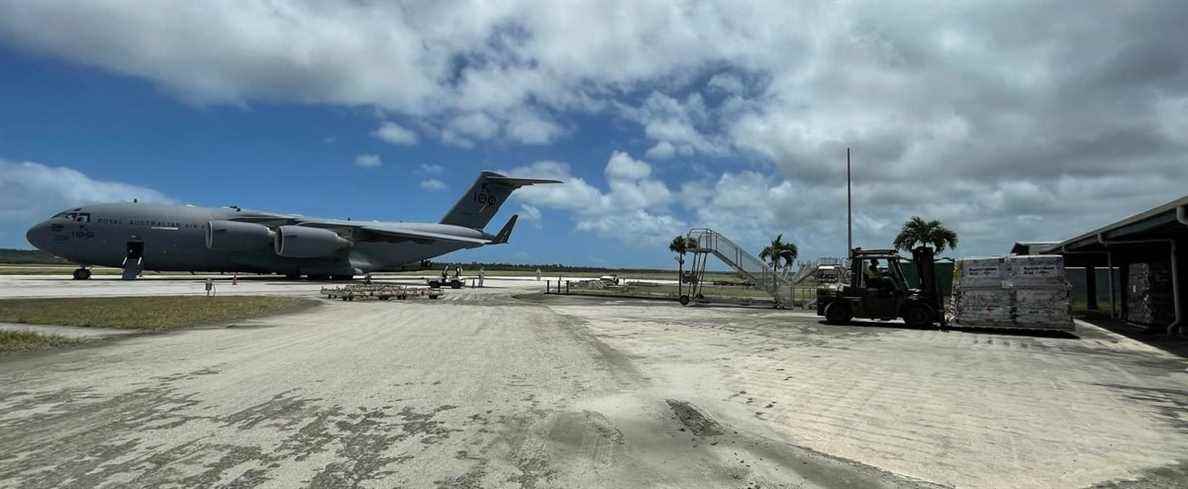The first planes carrying emergency aid and communications equipment landed on Thursday in the Tonga Islands, cut off from the world five days after a devastating eruption and tsunami.
• Read also: An explosive underwater volcano
• Read also: IN PICTURES | Tonga islands devastated after eruption and tsunami
The small Pacific nation has been isolated since the eruption on January 15 of the Hunga Tonga-Hunga Ha’apai volcano, one of the most powerful in the world for decades, which caused heavy damage as well as the rupture of the communications cable connecting the country to global internet and telephone networks.
Australian and New Zealand military planes landed at the archipelago’s main airport on the island of Tongatapu on Thursday, authorities said. The day before, after days of work, the track had finally been cleared of the five to ten centimeter layer of volcanic ash which made it unusable.
Australia sent a first C17 Globemaster plane loaded with aid on Thursday, and expected to take off a second aircraft during the day.
The New Zealand plane, meanwhile, is “carrying humanitarian aid and disaster relief supplies, including water containers, hygiene kits, temporary shelters, generators and equipment. communications,” said New Zealand Foreign Minister Nanaia Mahuta.
The first images from Nuku’alofa, the capital of Tonga, show buildings covered in ash, collapsed walls and streets littered with rocks, tree trunks and other debris.
About 84,000 people, more than 80% of Tonga’s population, were affected by the volcano’s eruption and subsequent tsunami, the UN said.
In particular, the archipelago faces an urgent need for drinking water. “Water supplies across Tonga have been severely affected by ashfall and salt water from the tsunami,” said Katie Greenwood, of the International Federation of Red Cross and Red Crescent Societies.
According to her, there is “a growing risk of diseases such as cholera and diarrhea”.
“ruined agriculture”
Tonga’s food reserves may not be sufficient. “All agriculture is ruined,” said the president of the country’s National Assembly, Fatafehi Fakafanua.
Since planes can land again, many nations have offered to help. Japan has announced the dispatch of two C-130 aircraft. Other countries including China and France have also announced their assistance.
The strict measures to prevent the entry into the country of COVID-19, which has so far spared it, will remain in force. Aid will be delivered without any physical contact, and crews and passengers will spend little time on the ground.
Help will also arrive by sea. Two New Zealand ships, HMNZS Wellington and HMNZS Aotearoa, carrying drinking water and a desalination unit that can supply 70,000 liters per day, are due to arrive in Tonga on Friday. Australia plans to sail the military ship HMAS Adelaide on the same day, with purification equipment and two Chinook helicopters on board.
Tonga’s government called the eruption an “unprecedented” disaster, saying waves up to 15 meters high destroyed all homes on some islands. Three people were killed.
The volcanic eruption, heard as far away as Alaska more than 9,000 km away. A mushroom of smoke 30 km high dispersed ash, gas and acid rain on Tonga’s 170 islands.
This eruption caused a huge pressure wave that crossed the planet, moving at a speed of 1,231 km / h, according to New Zealand’s National Institute for Water and Atmospheric Research.
It will take at least four weeks for Tonga’s internet connection to be restored by US cable company SubCom.
Satellite images from Maxar Technologies show a large expanse of water where much of the volcano rose above the sea before the eruption. Only two relatively small volcanic islands remain emerged.
